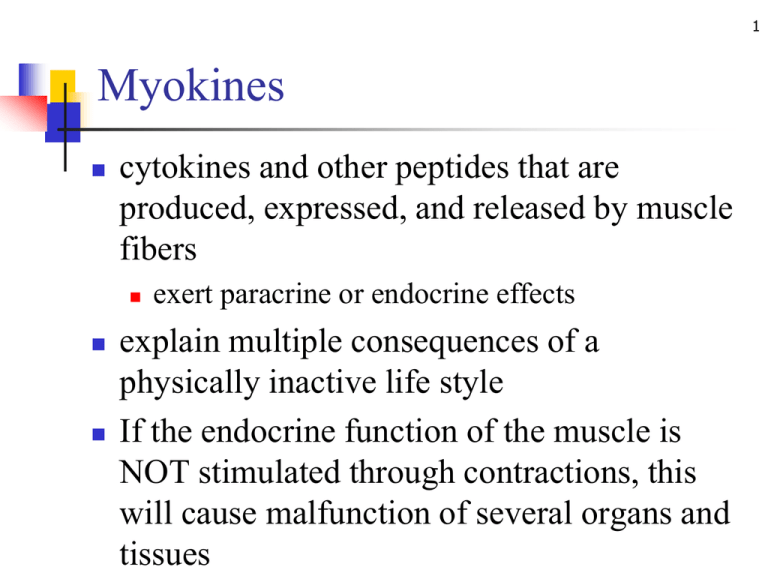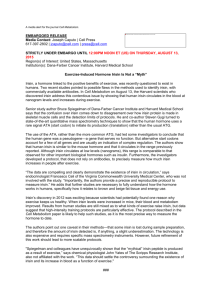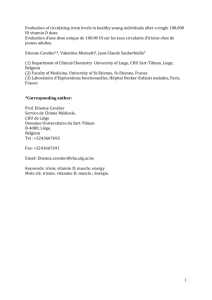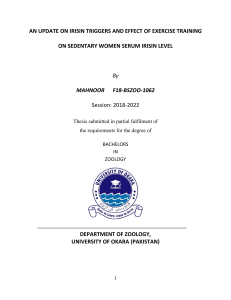PowerPoint 簡報
advertisement

1 Myokines cytokines and other peptides that are produced, expressed, and released by muscle fibers exert paracrine or endocrine effects explain multiple consequences of a physically inactive life style If the endocrine function of the muscle is NOT stimulated through contractions, this will cause malfunction of several organs and tissues 2 Myokines interleukin IL-6, IL-8, IL-15, BDNF, LIF, FGF21, Follistatin-like-1 contracting skeletal muscles release myokines with functions: hormone-like function, specific endocrine effects on visceral fat and other ectopic fat deposits. work locally within the muscle via paracrine mechanisms, on signaling pathways involved in fat oxidation. Mediating inflammatory pathway organ cross talk, including muscle–fat cross talk Diseasome of physical inactivity Pedersen, 2011 3 4 Myokines and visceral fat Hypothesis: physical inactivity is an independent cause of fat accumulation in ‘the wrong places’. Exercise ↓ chronic diseases associated with chronic inflammation One reason: ↓ visceral fat Pedersen, 2011 5 Interleukin-6 First identified, most studied myokine ↑100 X in blood during exercise IL-6 is markedly produced and released in the post exercise period when insulin action is enhanced but, IL-6 has also been associated with obesity and reduced insulin action Pedersen, 2011 6 IL-6 Within skeletal muscle, IL-6 acts locally to activate AMP-kinase and/or PI3-kinase ↑ glucose uptake and fat oxidation in muscle Hormone-like:↑hepatic glucose production, ↑lipolysis in adipose tissue muscular IL-6 NOT activate NF-kB signaling exercise-induced IL-6 response is NOT mediating strong pro-inflammatory activities IL-6 in macrophage, activate NF-kB, ↑inflammation Pedersen, 2011 7 IL-6 Following exercise, IL-6 induce high circulating levels of IL-6 are followed by ↑ IL-1ra and IL-10, anti-inflammatory cytokines IL-1ra inhibit IL-1 function, bind to IL-1 receptor but induce no response Muscle-derived IL-6 ↓TNF-alpha, ↓IL-1 production Part of the mechanism for exercise-induced Pedersen, 2011 anti-inflammatory effect 8 Anti-inflammatory effect of exercise Exercise increases the release of epinephrine, cortisol, growth hormone, prolactin 3 hr cycling, or infusion of IL-6, ↓ TNF-a secretion induced by endotoxin Typically, IL-6 is the first cytokine released into the circulation during exercise immunomodulatory effects Then IL-1ra, IL-10, also anti-inflammatory pro-inflammatory cytokines,TNF-a and IL1b, in general NOT increase with exercise Anti-inflammatory cytokines released after exercise Pedersen, 2009 9 10 MunozCanoves, 2013 11 IL-15: muscle-fat cross talk IL-15 accumulate within the muscle after regular training. Negative association between plasma IL-15 concentration and trunk fat mass, but not limb fat mass, in humans IL-15 overexpressed in mouse muscles, ↓ visceral fat mass, but not subcutaneous fat mass Pedersen, 2011 12 brain-derived neurotrophic factor BDNF regulate survival, growth, and maintenance of neurons, learning and memory Alzheimer’s patients: ↓ BDNF expression in Hippocampal, ↓ BDNF in plasma impaired memory and general cognitive function in ageing women associated with ↓ plasma BDNF ↓ BDNF in plasma associated with ↑ mortality in old women, ↑ obesity, ↑ type 2 DM, ↑ depression, ↑ insulin resistance Pedersen, 2011 13 brain-derived neurotrophic factor In humans, cerebral output of BDNF at basal condition, ↑ BDNF mRNA and protein in human skeletal muscle after exercise ↓ cerebral output of during hyperglycaemic clamp muscle-derived BDNF not to be released into the circulation BDNF ↑ phosphorylation of AMPK and ACC ↑ fat oxidation ACC (acetyl-CoA carboxylase): acetyl-CoA malonylCoA Pedersen, 2011 14 brain-derived neurotrophic factor BDNF regulate fat metabolism, with a subsequent effect on the size of adipose tissue In autocrine or paracrine fashion Pedersen, 2011 Diseasome of low BDNF similar to that of physical inactivity Pedersen, 2009 15 16 Fibroblast growth factor 21 FGF21 is a unique FGF with metabolic, but not proliferative activities Fibroblast growth factor (FGF) family: signaling proteins with diverse functions in development and metabolism FGF 21 as hepatokine, adipokine, and myokine in metabolism, injury protection, and diseases Itoh, 2014 17 FGF21 functions Itoh, 2014 18 FGF21 as biomarker of diseases Itoh, 2014 19 FGF21 expression of FGF21 regulated by PI3K/Akt1 signaling pathway Down-stream of insulin signal In Akt1 transgenic mice: ↑ Skeletal muscle hypertrophy, ↑ FGF21 ↑ FGF21 in muscle by various types of stress Mitochondria dysfunction, respiratory chain inhibitors ↑ protection against diet-induced obesity and insulin resistance increased browning of white adipose tissue (↑ uncoupling protein 1, UCP-1) in an endocrine manner Itoh, 2014 20 irisin Irisin: exercise-induced myokine, with potential to induce “browning” of white adipocytes in mice BAT higher metabolic rate than WAT, mostly due to expression of UCP1 In mouse, ↑ PGC1-α in muscle ↑ browning of subcutaneous WAT similar to traditional exercise effects Irving, 2014 Putative effect of irisin on browning of white adipose tissue 21 Irving, 2014 22 irisin cultured primary mouse subcutaneous adipocytes with conditioned media from PGC1-α over expressing mouse myocytes ↑ expression of brown-fat-specific genes One or more myokine responsible for the change Target gene: Fibronectin type III domain-containing 5 (FNDC5), protein product named ‘irisin’ secreted form of irisin was highly homologous between mouse and humans N-terminal (extracellular) fragments of irisin in cell culture media and/or plasma Irving, 2014 23 Irisin in humans Exercise training ↑ irisin in plasma and muscle expression? Inconclusive No effect in a randomized clinical trial of (n=102) middle aged participants after 26 wk training Muscle Irisin NO effect on browning of human pre-adipocytes Irving, 2014 24 Irisin Expression of irisin in WAT < 5% of that observed in skeletal muscle in humans Although may serve as adipokine to regulate ↓ Irisin gene expression in muscle and adipose tissue, ↓irisin in blood, in type 2 DM and obese humans Irisin gene expression in visceral and subcutaneous WAT positively associated with brown adipose tissue markers (PRDM16 and UCP1) in humans Irving, 2014 25 Leukaemia inhibitory factor Originally found secreted from ascites tumour cells, with ability to induce terminal differentiation of myeloid leukaemic cells LIF, synthesis and released following exercise, stimulates muscle satellite cell proliferation and is involved in muscle hypertrophy and regeneration LIF may be produced by skeletal muscle during exercise to contribute to local aspects of muscle adaptation to exercise. Broholm, 2013 26 IL-6 family and their receptor Broholm, 2013 27 Leukaemia inhibitory factor exercise induces LIF mRNA in human skeletal muscle ↑ 4X after endurance, 9X after heavy resistance ↓gradually throughout the post-exercise period LIF protein levels remain unaltered, repetitive bouts of exercise are necessary Broholm, 2013 28 LIF and muscle hypertrophy LIF ↑ proliferation of myoblast and satellite cells, while preventing premature differentiation, by ↑ signaling cascade involving JAK1, STAT1 and STAT3 muscle adaptation and hypertrophy depend on the addition of new myonuclei by way of proliferation and further fusion of satellite cells to the adult muscle fibers LIF plays a role Broholm, 2013 29 LIF and muscle regeneration LIF ↑ muscle regeneration in mice suffering from muscle dystrophy LIF restores the hypertrophic response to increased loading in LIF (-/-) mice LIF an important factor in skeletal muscle hypertrophy Broholm, 2013 30 muscle-derived LIF in muscle hypertrophy and regeneration Broholm, 2013 31 Conclusions identification of skeletal muscle as an endocrine organ that produces and releases myokines expands our knowledge on how muscle-derived factors contribute to exercise adaptation, inflammation, and various chronic diseases Myokines appear to have important local effects within the muscle, including effects on metabolism, angiogenesis and muscle growth Myokines also have endocrinological functions 32 Conclusions IL-6 influences metabolism in skeletal muscle, adipose tissue and the liver, regulating satellite cellmediated hypertrophy IL-8 affect angiogenesis IL-15 ↓adipose tissue mass LIF regulate satellite cells, similar to IL-6. IL-6 and LIF share the gp130 receptor component of their signalling complexes and show high homology in their tertiary structures timing and balance between these cytokines still unclear











